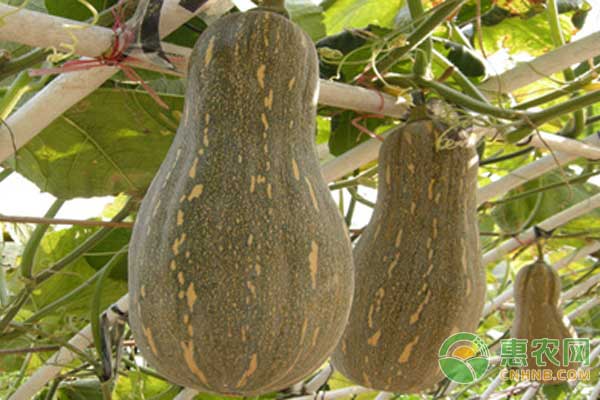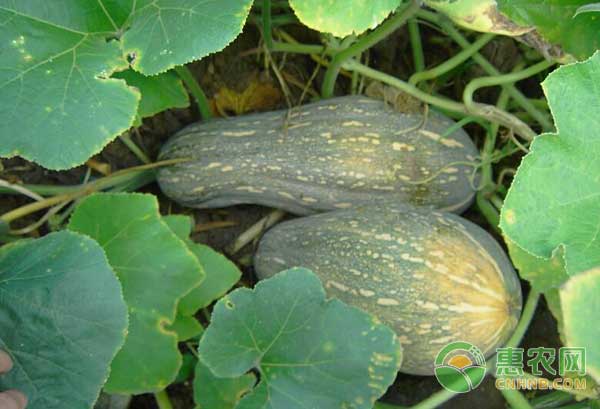Honey pumpkin is also called dog meat pumpkin. It is a hybrid of early-maturing varieties with strong resistance, wide adaptability, good quality and high yield. The honey pumpkin rind is orange-yellow, the flesh is thick, the fleshy surface is fine, the moisture is small, and the taste is sweet and refreshing. The yield per mu is 2000 kilograms, and the planting benefits are remarkable. Here is a brief introduction to the high-yield and efficient planting techniques of the secret pumpkin. First, soil preparation, application of base fertilizer, cover film The fertile soil is loose and well-drained. In the past two years, the loam of pumpkin has not been planted. After the land is tilled and flattened, the width of the face is 6.0m, the middle and high sides are low, the bottom of the ditch is 30cm wide, and the ditch is 20-30cm deep. The ditch and the waist groove are deepened. On both sides, a small groove 20cm wide and 20cm deep is opened at 30cm from the side of the crotch. Each 667m2 of farmer's fertilizer 800kg, potassium chloride 30kg, superphosphate 50kg, mix the soil, flatten the surface, cover film compression. Second, sowing seedlings 1. Preparation of nutrient soil The preparation of nutrient soil is based on the principle of high organic matter content, no pollution and no pest source. Take fertile, loose, vegetable garden soil that has not been planted in 3 years. After 2 to 3 times of turning over the sun, then apply high-quality farmyard manure, fully sifted and sieved. It is prepared in the proportion of 6 parts of garden soil: 2 parts of organic fertilizer: 2 parts of carbonized rice husk. When mixing nutrient soil, add appropriate amount of water to grasp the slightest humidity in the hand. The prepared nutrient soil is preferably piled up in a nursery shed and covered with a film for 15 to 20 days. It is advisable to use a nutrient bowl for pumpkin seedlings with a diameter of 8 cm or a diameter of 10 cm. The nutrient soil is placed 1 to 2 days before the seedling or transplanting, and is neatly discharged into the nursery bed. The seedling bed is 1 to 1.2 m wide and 10 to 15 cm high, and the length is determined according to the seedling amount. 2, bagging 3-5 days before sowing, bagging in the nursery field (where leeward is selected), 300 bags per 667 m2, covered with agricultural film. 3, soaking seeds and germination Before soaking seeds, choose to dry for 1-2 days, then pour the seeds into hot water of about 55 °C for 20 minutes, then soak them in warm water of 25-30 °C for 4 hours, and clean them with gauze bags. The net bag is wrapped, placed under the condition of 30 ~ 32 ° C germination (with electric blanket germination, temperature can not exceed 35 ° C), washed twice daily with 30 ° C warm water, turn the seeds 4 times a day, keep the germination material moist, When 80% of the seeds are white, they can be sown. 4, planting time The sowing time varies according to the local cultivation habits. Generally, the Zunyi area is around March 20th. On the afternoon before sowing, the prepared nutrients are drenched and drenched. Insert a 2cm deep hole with the index finger in the middle of the sputum, put the germinated seeds in the hole, cover the nutrient soil, get wet, insert the scaffolding, cover the membrane. Ungerminated seeds continue to germination and are sown after germination. We can broadcast live seedlings or mulch seedlings in the local area. Seedlings are planted in the area above 1200 meters above sea level in April; the seedlings in the areas below 1200 are most suitable for March; harvest from June to July. 5, seedling temperature management Pre-emergence high temperature promotes seedlings, the temperature is controlled at 25-35 °C, and the seed after germination can be emerged in about 36 hours. When 60% of the seeds are broken, the film is removed, the film is removed in time, the high temperature is burned and the length is lowered, and the temperature is lowered to the appropriate temperature. 22-25 ° C during the day, the night temperature is not lower than 15 ° C, which is favorable for the formation of short and strong seedlings. In the 2-3 days after the transplanting, the seedlings are promoted by high temperature and high humidity, and even if the temperature is above 35 °C, the burning phenomenon will not occur. After 3 days, you need to gradually increase the ventilation and cool down to 25 °C. When the first true leaf is nearly 3cm in size, it indicates that the slow seedling period has ended, and the seedbed has entered a state of proper temperature management. The daytime control is 25-35°C, the nighttime is not lower than 15°C, and the temperature is lowered to 3-5 days before the planting. °C, low temperature refining at no less than 12 °C at night. 6. Seedling water management The amount of water required for pumpkin seedlings is small, and should be based on the principle of less amount of pouring. Generally, in the condition of pouring the bottom water, the seedling is transferred from the emergence to the cotyledon stage without watering. After the seedlings are transplanted or transplanted, it is better to keep the surface of the soil from whitish. When cultivating water in an appropriate amount, it should be selected from 10:00 am to 2:00 pm on sunny days, often replenishing water, and it is easy to reduce soil temperature and produce dead seedlings and cockroaches. root. In the high-humidity state of the nutrient-stained soil, when the air humidity in the nursery shed reaches 80% or more, the shallow bamboo soil is lightly ground with a small bamboo stick to increase the ventilation, which is beneficial to warming and reducing the humidity and reducing the disease at the seedling stage. 7. Fertilizer management in seedling stage Pumpkin seedlings generally do not require supplemental fertilizer. Third, transplanting When 4-5 pieces of true leaves are selected for sunny transplanting, each row is planted in two rows, the plant spacing is 70-80cm, root water is poured, and the mulch around the planting area is covered with soil, and 250-300 plants per acre are planted. 4. Pruning and fertilizer management When the plants are topped before vines, leave 2-3 side branches. In the early stage, the fertilizer and water were controlled. After fruit setting, topdressing was carried out 2-3 times. Each time 10 kg of compound fertilizer was applied to the roots 20 cm away from the roots, or directly after the rain, 5 kg of urea and 5 kg of potassium fertilizer were mixed and then applied. If the vegetative growth is too strong in the middle of the growth period, the vine can be gently lifted to cut the adventitious root of the pumpkin and reduce the rate of nutrient absorption. Or gently rotate the main vine 1.5m away from the root to reduce nutrient transport. Five, pest control The main diseases of pumpkins are powdery mildew and viral diseases. The main pests are aphids and larvae. 1, powdery mildew It is the main common disease of pumpkin. The pathogens overwinter with the diseased bodies in the soil or shed. The onset temperature is 20 ~ 25 ° C, the air humidity is large, the temperature is 16 ~ 24 ° C or the dry and wet alternate when the incidence is heavy. It can occur in the seedling stage and adult stage, and the disease is heavier in the middle and late stages, mainly affecting the leaves, petiole and stem. In the early stage of the disease, white mildew spots appeared on the leaves or tender stems. When the conditions were suitable, the mildew spots rapidly expanded and the white powder covered the whole leaves, causing the leaves to be yellow. Control methods: 1 clean the pastoral, clear the sick leaves and old leaves in the field. 2 In the early stage of the disease, 15% powder rust WP 1500 times solution, 10% Shigao water granules 1500-2000 times solution, 50% thiophanate 500 times solution, and green enjoyment No. 2 600-800 times solution were alternately controlled. Spray once every 5~7d, even spray 2~3 times. 2, mosaic virus disease The main disease for pumpkins. It is mainly caused by the poisoning of seeds or the aphids, white meal or sweat. In summer, when the temperature is high and the drought occurs, the incidence of insect pests is serious. At the beginning of the disease, the macula and the mottled mosaic leaves of different shades appear. In severe cases, the leaf surface is uneven and the veins are shrunk and deformed. The disease of the new leaves is obvious, and the stems and growth points are curled up in the later stage of the disease. The fruit showed chlorotic lesions after the disease, and the fruit was uneven. Control methods: 1 select disease-free seeds, the seeds were sterilized with 10% sodium phosphate for 20 min before sowing, rinsed with water and soaked for 2 h. 2 During the whole growth period, use 0.3% potassium dihydrogen phosphate solution or spray foliar fertilizer, and apply fertilizer once every 10 days to increase disease resistance. 3 In the early stage of the disease, use 20% virus A wettable powder 500 times liquid or 20% poison star killing wet powder 500 times liquid alternately control, 7d spray once, even spray 2 to 3 times. 3, locusts The worm body is black, divided into winged scorpion and wingless scorpion, which can spread the virus. Eggs overwinter on the host, and nymphs continue to multiply on greenhouse vegetables. It can be propagated in the temperature range of 6 to 27 ° C, and the suitable temperature is 16 to 20 ° C. The speed of reproduction of melons is rapid. The Yangtze River Basin can occur 20 to 30 generations per year, and the south is over 27 °C. The relative humidity of 75% or more is not conducive to melon breeding. The aphids suck the juice on the leaves, tender stems and young leaves of the seedlings. After the young leaves and growth points were killed, the leaves were coal-soiled, the leaves were curled, the melon seedlings were wilting, and the growth stagnated until they died. In the adult stage, the leaves are dried up in advance, shortening the period of fruiting, resulting in reduced yield. Control methods: 1 clean the pastoral, remove the weeds in the field, eliminate the overwintering eggs, and use the yellow plate to induce cockroaches and silver-gray film to avoid cockroaches. 2 In the initial stage of aphid damage, spray with 2% imidacloprid WP 2500 times solution, 0.5% keiling WP 2500 times solution, spray once every 5~6d, spray 3~4 times, prevent early, in the leaf back The tender stems and tender tips should be sprayed centrally. Sixth, harvest 35 days after the fruit set, the melon red ripening can be harvested, stop the irrigation 15 days before harvesting, pay attention to light handling when harvesting, so as to avoid mechanical damage. Honey squash has high yield and good economic benefits, and can be widely planted. China Extract Powder For Use As Dietary Supplement Extract Powder, Extract Powder Manufacturer Shaanxi Kang New Pharmaceutical co., Ltd. , https://www.bodybuildingoil.com
